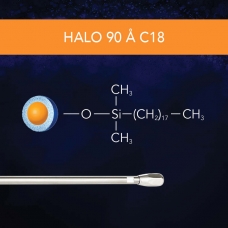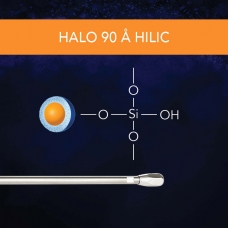UHPLC and HPLC Columns
Product Listing
Providing Top-Quality HPLC Columns In Singapore
In High-Performance Liquid Chromatography (HPLC), columns play a significant role in separating the components of a sample based on the differences in their affinity or retention strength for the stationary phase and mobile phase. With current advancements in LC, technology has evolved to offer smaller particle size HPLC columns with higher sensitivity and resolution to be used for high-performance liquid chromatography (HPLC) and ultra-high-performance liquid chromatography (UHPLC).
There are many different types of HPLC columns available. Choosing the most suitable HPLC column for separation is usually determined by the type of application needed. Various samples may also require different types of HPLC columns. The types of columns include C18, C8, Phenyl, PFPP, NH2, CN, Silica, and more. These are also available in analytical and preparative (prep) column dimensions.
With all of these to consider, you’d need to find a supplier that can give you a dedicated column for the different types of applications.
Shimadzu is in the business of providing a wide range of products, from analytical instruments to medical systems, aiding in the research and development of various industries worldwide. Our goal is to make our supply of lab consumables, particularly HPLC consumables, more accessible to companies in Singapore, including pharmaceutical companies and companies that deal with environmental and chemical safety.
Shimadzu strives to make HPLC columns, GC columns, sample vials, and other laboratory consumables more accessible for various industries in Singapore and the APAC region. If you’re looking for a reliable supplier for HPLC columns, do not hesitate to contact us or visit Shimadzu for an instant quotation. Whether you need columns for normal phase, reversed phase, ion exchange, size exclusion, HILIC, or Ion Chromatography HPLC, you can definitely find what you need with us. Buy HPLC columns online today at ShopShimadzu.
What Are HPLC Guard ColumnsUsed for and How to Choose One?
HPLC guard columns are installed in front of the main analytical or prep HPLC columns to prolong the lifetime of the main column. They function to remove highly absorptive compounds and particulate contaminants from samples preventing the contaminants from causing irreversible damage to the main columns. The guard column can be replaced when contaminants build up on the guard column and affect the analysis, which is more cost-saving compared to replacing the more expensive main column.
HPLC guard columns should have the same packing material as the main column. In terms of dimension, the internal diameter (ID) of the guard column should be the same as the main column. If the same ID guard column is not available, the nearest smaller ID guard column should be chosen. The length of the guard column should also be minimal to reduce the dead volume added. However, it is crucial to note that the guard column should be long enough to prevent any compounds that should be retained by the guard column from reaching the main column.
Frequently Asked Questions About HPLC Columns
1. What are the common types of HPLC Columns used?
There are a diverse array of HPLC consumables that have emerged to meet the demands of various analytical applications. These consumables, particularly the HPLC columns, play a pivotal role in separating and analysing complex mixtures with unparalleled precision and efficiency. Each HPLC column is designed with unique characteristics to cater to specific analytical requirements. Here are the most common types:
- Normal Phase Columns - Normal Phase separation is one of the earliest developed liquid chromatography separation methods. The stationary phase of normal phase columns is polar, while the mobile phase is non-polar, which is the opposite of a reverse phase column. Some of the applications of normal phase separation include analysis of sugar which are difficult to be retained by reversed phase columns, separation of tocopherol isomers, which cannot be achieved using reverse phase separation, and separation of easily hydrolysable compounds, such as acid anhydrides whereby the absence of water in the mobile phase essential in preventing hydrolysis of the compounds. Although the application of normal phase columns is rather limited, this separation technique still remains invaluable in liquid chromatography.
- Reversed Phase Columns - Reverse phase (RP) separation is one of the most commonly used HPLC separation modes. Reversed phase columns have a stationary phase that is non-polar, while the mobile phase is polar. Reversed phase columns are used in a wide variety of applications, including pharmaceutical, chemical, life science, forensic, food and agriculture, environmental, and more. Examples of reversed phase columns include C18 or also called ODS, C8, phenyl and pentafluorophenyl (PFP).
- HILIC Columns – Hydrophilic Interaction Liquid Chromatography (HILIC) can be considered a variation of normal phase chromatography. The major difference between the normal phase and HILIC is that in the normal phase, the mobile phase is 100% organic, and the elution of the analyte is achieved using a more polar organic mobile phase. In HILIC, the water-miscible organic mobile phase is used, and elution of the analyte is usually achieved using an aqueous buffer or water. Particles in HILIC columns are surrounded by an aqueous layer, and analytes that are soluble in the aqueous layer can be retained by the polar stationary phase through multiple types of interactions, including partitioning between the aqueous layer and the mobile phase, hydrogen bonding, electrostatic repulsion, or attraction with the stationary phase. Due to the high content of the organic solvent in the mobile phase, the detection sensitivity for MS detectors is also increased. HILIC has gained increasing popularity for polar analytes that are difficult to retain using reversed phase columns. Examples of HILIC stationary phases include the diol and amide phases. They are commonly used for the separation of sugar alcohol and derivatised oligosaccharides.
- Ion Exchange Columns - Ion exchange chromatography separates analytes based on ionic interaction between the analytes and the stationary phase. Ion exchange columns are commonly used for charged molecules such as inorganic ions, amino acids, peptides, proteins, nucleotides, and nucleic acids. There are two types of ion exchange columns, the anion exchange columns and the cation exchange columns. An anion exchange column contains particles that are positively charged and are used to retain negatively charged anionic analytes. On the other hand, a cationic exchange column contains particles that are negatively charged and are used to retain positively charged cationic analytes. Elution of analytes can be achieved either by increasing the concentration of exchangeable counter ions or by altering the pH of the mobile phase.
- Size Exclusion Columns - Size exclusion chromatography (SEC) utilises the phenomenon in which solute molecules either infiltrate or are excluded from the pores of porous column packing according to the pore diameter (size). In general, a technique that uses hydrophobic packing material and a non-aqueous (organic solvent) mobile phase to analyse the molecular weight distribution of synthetic polymers is called Gel Permeation Chromatography (GPC). Another technique that uses hydrophilic packing material and an aqueous mobile phase for separation and molecular weight distribution analysis of polysaccharides, proteins and other aqueous macromolecules is called Gel Filtration Chromatography (GFC).
2. What is a preparative HPLC column?
Preparative (prep) HPLC columns are an essential tool in the field of compound purification, serving to isolate and collect pure compounds for subsequent utilisation. These columns are specifically designed to handle larger sample loading capacities, necessitating a relatively wider internal diameter ranging from 10mm to 50mm. By accommodating larger quantities of the sample, prep columns enable efficient purification of compounds.
Prep columns play a crucial role in various applications, such as pharmaceutical research and development, natural product isolation, and chemical synthesis. They facilitate the separation and purification of complex mixtures, enabling scientists to obtain highly pure compounds for further analysis, characterisation, and utilisation.
3. How does a prep column differ from an analytical column?
Preparative (prep) columns and analytical columns differ in several key aspects, including their primary function, internal diameter, and sample loading capacity. While prep columns primarily serve the purpose of purifying compounds, analytical columns are predominantly employed for qualitative and quantitative analysis of substances and are designed to handle smaller sample volumes associated with qualitative and quantitative analysis. Therefore, they possess a narrower internal diameter, typically between 2mm and 4.6mm.









